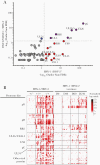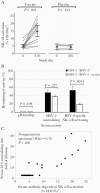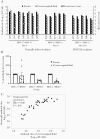Serum and Cervicovaginal Fluid Antibody Profiling in Herpes Simplex Virus-Seronegative Recipients of the HSV529 Vaccine
- PMID: 33718970
- PMCID: PMC8599754
- DOI: 10.1093/infdis/jiab139
Serum and Cervicovaginal Fluid Antibody Profiling in Herpes Simplex Virus-Seronegative Recipients of the HSV529 Vaccine
Abstract
Previous herpes simplex virus type 2 (HSV-2) vaccines have not prevented genital herpes. Concerns have been raised about the choice of antigen, the type of antibody induced by the vaccine, and whether antibody is present in the genital tract where infection occurs. We reported results of a trial of an HSV-2 replication-defective vaccine, HSV529, that induced serum neutralizing antibody responses in 78% of HSV-1-/HSV-2- vaccine recipients. Here we show that HSV-1-/HSV-2- vaccine recipients developed antibodies to epitopes of several viral proteins; however, fewer antibody epitopes were detected in vaccine recipients compared with naturally infected persons. HSV529 induced antibodies that mediated HSV-2-specific natural killer (NK) cell activation. Depletion of glycoprotein D (gD)-binding antibody from sera reduced neutralizing titers by 62% and NK cell activation by 81%. HSV-2 gD antibody was detected in cervicovaginal fluid at about one-third the level of that in serum. A vaccine that induces potent serum antibodies transported to the genital tract might reduce HSV genital infection.
Keywords: HSV-2; antibody-dependent cellular cytotoxicity; genital herpes; glycoprotein D; herpes simplex; herpesvirus; replication-defective vaccine; vaccine.
Published by Oxford University Press for the Infectious Diseases Society of America 2021.
Figures







Similar articles
-
Better neutralization of herpes simplex virus type 1 (HSV-1) than HSV-2 by antibody from recipients of GlaxoSmithKline HSV-2 glycoprotein D2 subunit vaccine.J Infect Dis. 2014 Aug 15;210(4):571-5. doi: 10.1093/infdis/jiu177. Epub 2014 Mar 20. J Infect Dis. 2014. PMID: 24652496 Free PMC article. Clinical Trial.
-
Immunogenicity, protective efficacy, and non-replicative status of the HSV-2 vaccine candidate HSV529 in mice and guinea pigs.PLoS One. 2015 Apr 2;10(4):e0121518. doi: 10.1371/journal.pone.0121518. eCollection 2015. PLoS One. 2015. PMID: 25837802 Free PMC article.
-
A Randomized, Double-Blinded, Placebo-Controlled, Phase 1 Study of a Replication-Defective Herpes Simplex Virus (HSV) Type 2 Vaccine, HSV529, in Adults With or Without HSV Infection.J Infect Dis. 2019 Aug 9;220(6):990-1000. doi: 10.1093/infdis/jiz225. J Infect Dis. 2019. PMID: 31058977 Free PMC article. Clinical Trial.
-
The challenge of developing a herpes simplex virus 2 vaccine.Expert Rev Vaccines. 2012 Dec;11(12):1429-40. doi: 10.1586/erv.12.129. Expert Rev Vaccines. 2012. PMID: 23252387 Free PMC article. Review.
-
Development of prophylactic vaccines for genital and neonatal herpes.Expert Rev Vaccines. 2003 Aug;2(4):541-9. doi: 10.1586/14760584.2.4.541. Expert Rev Vaccines. 2003. PMID: 14711338 Review.
Cited by
-
Novel Mouse Model of Recurrent Sublethal Herpes Simplex Virus Infection Recapitulates Human Antibody Responses to Primary and Chronic Infection.Vaccines (Basel). 2024 Oct 1;12(10):1127. doi: 10.3390/vaccines12101127. Vaccines (Basel). 2024. PMID: 39460294 Free PMC article.
-
An Insight into Current Treatment Strategies, Their Limitations, and Ongoing Developments in Vaccine Technologies against Herpes Simplex Infections.Vaccines (Basel). 2023 Jan 17;11(2):206. doi: 10.3390/vaccines11020206. Vaccines (Basel). 2023. PMID: 36851084 Free PMC article. Review.
-
Human Antibodies against Herpes Simplex Virus 2 Glycoprotein G Do Not Neutralize but Mediate Antibody-Dependent Cellular Cytotoxicity.Antibodies (Basel). 2024 May 11;13(2):40. doi: 10.3390/antib13020040. Antibodies (Basel). 2024. PMID: 38804308 Free PMC article.
-
Developments in Vaccination for Herpes Simplex Virus.Front Microbiol. 2021 Dec 7;12:798927. doi: 10.3389/fmicb.2021.798927. eCollection 2021. Front Microbiol. 2021. PMID: 34950127 Free PMC article. Review.
References
-
- Kohl S. Role of antibody-dependent cellular cytotoxicity in neonatal infection with herpes simplex virus. Rev Infect Dis 1991; 13:S950–2. - PubMed
-
- Sullender WM, Miller JL, Yasukawa LL, et al. . Humoral and cell-mediated immunity in neonates with herpes simplex virus infection. J Infect Dis 1987; 155:28–37. - PubMed
-
- Prober CG, Sullender WM, Yasukawa LL, Au DS, Yeager AS, Arvin AM. Low risk of herpes simplex virus infections in neonates exposed to the virus at the time of vaginal delivery to mothers with recurrent genital herpes simplex virus infections. N Engl J Med 1987; 316:240–4. - PubMed
Publication types
MeSH terms
Substances
Grants and funding
LinkOut - more resources
Full Text Sources
Other Literature Sources
Medical

